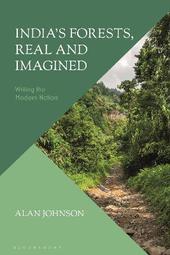
|
India's Forests, Real and Imagined: Writing the Modern Nation
Hardback
Main Details
| Title |
India's Forests, Real and Imagined: Writing the Modern Nation
|
| Authors and Contributors |
By (author) Alan Johnson
|
| Physical Properties |
| Format:Hardback | | Pages:280 | | Dimensions(mm): Height 234,Width 156 |
|
| Category/Genre | The environment |
|---|
| ISBN/Barcode |
9780755634101
|
| Classifications | Dewey:809.933585400952 |
|---|
| Audience | | Tertiary Education (US: College) | |
|---|
| Illustrations |
10 bw illus
|
|
Publishing Details |
| Publisher |
Bloomsbury Publishing PLC
|
| Imprint |
Bloomsbury Publishing PLC
|
| Publication Date |
26 January 2023 |
| Publication Country |
United Kingdom
|
Description
As they seek to explore evolving and conflicting ideas of nationhood and modernity, India's writers have often chosen forests as the dramatic setting for stories of national identity. India's Forests, Real and Imagined explores how these settings have been integral to India's sense of national consciousness. Alan Johnson demonstrates that modern writers have drawn on older Indian literary traditions of the forest as a place of exile, trial and danger to shape new ideas of India as a modern nation. The book casts new light on a wide range of modern writers, from Bankim Chandra Chattopadhyay - widely regarded as the first Indian novelist - to contemporary authors such as Amitav Ghosh, Arundhati Roy, and Salman Rushdie as well as local attitudes to nationhood and the environment across the country.
Author Biography
Alan Johnson is Professor of English at Idaho State University, USA. He is the author of Out of Bounds: Anglo-Indian Literature and the Geography of Displacement (2011) and articles on topics ranging from environmental literature in India to Hindi film.
ReviewsWe are currently witnessing a renaissance of arboreal literary criticism and cultural studies throughout the world. Alan Johnson's India's Forests, Real and Imagined: Writing the Modern Nation richly explores the meaning of trees and forests in Indian literary works from the past century and a half, revealing the many dimensions of "arboreal India" but focusing chiefly on the use of forest imagery in critiquing colonialism and conceptualizing Indian nationalism. This is a clear, accessible, and authoritative introduction to Indian literature and to the significance of forests in many of India's diverse subcultures. * Scott Slovic, University of Idaho, USA, and co-editor of Nature and Literary Studies * Indian forests are sites of ambivalence signifying both purity, contemplation as well as doubleness and conflict. How does one understand the arankayas, the forest texts of India, both classical and contemporary, in the context of Global South Anthropocene conditions - the destruction of forestlands, displacement of indigenes and loss of livelihoods? How do these forests, both real and imagined become key sites for articulating national and regional identities? How do Indian writers counter Western colonial tropes by drawing on their own rich corpus of forest narratives? India's Forests Real and Imagined considers these questions by skilfully knitting together a wide variety of texts from the Sanskrit epics to contemporary literary narratives that are connected by the trope of the forest. The book teases out the invisible connections that the arboreal forges between urban spaces and wilderness, the ascetic and erotic. Most importantly, this book reimagines received histories by employing darshana -the traditional Indian term for the dialogic mode of devoted seeing- as a multi-layered sight tool that opens up multiple free narrative spaces in which no single version is made to bear the burden of representation. Lucidly articulated and argued, this book is the first of its kind to undertake a full length study of forest narratives from India and has important implications for ecocritical scholarship. * Swarnalatha Rangarajan, Professor, IIT Madras, India *
|